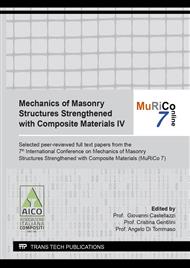[1]
X. Zou, P. Feng, Y. Bao, J. Wang, and H. Xin, Experimental and analytical studies on shear behaviors of FRP-concrete composite sections,, Eng. Struct., vol. 215, p.110649, Jul. 2020,.
DOI: 10.1016/j.engstruct.2020.110649
Google Scholar
[2]
D. Baggio, K. Soudki, and M. Noël, Strengthening of shear critical RC beams with various FRP systems,, Constr. Build. Mater., vol. 66, no. September 2014, p.634–644, 2014,.
DOI: 10.1016/j.conbuildmat.2014.05.097
Google Scholar
[3]
M. Tariq and J. P. Newhook, Shear testing of FRP reinforced concrete without transverse reinforcement,, Proceedings, Annu. Conf. - Can. Soc. Civ. Eng., vol. 2003, no. January 2003, p.1330–1339, (2003).
Google Scholar
[4]
P. J. Heffernan and M. A. Erki, Fatigue behavior of reinforced concrete beams strengthened with prestressed fiber reinforced polymer,, Compos. Constr., vol. 8, no. 1, p.132–140, 2004,.
DOI: 10.1061/(asce)1090-0268(2004)8:2(132)
Google Scholar
[5]
H. R. Hamilton III and C. W. Dolan, Flexural Capacity of Glass FRP Strengthened Concrete Masonry Walls,, J. Compos. Constr., vol. 5, no. 3, p.170–178, (2001).
DOI: 10.1061/(asce)1090-0268(2001)5:3(170)
Google Scholar
[6]
S. M. Raoof, L. N. Koutas, and D. A. Bournas, Textile-reinforced mortar (TRM) versus fibre-reinforced polymers (FRP) in flexural strengthening of RC beams,, Constr. Build. Mater., vol. 151, p.279–291, 2017,.
DOI: 10.1016/j.conbuildmat.2017.05.023
Google Scholar
[7]
S. M. Raoof and D. A. Bournas, TRM versus FRP in flexural strengthening of RC beams: Behaviour at high temperatures,, Constr. Build. Mater., vol. 154, p.424–437, 2017,.
DOI: 10.1016/j.conbuildmat.2017.07.195
Google Scholar
[8]
Z. C. Tetta, L. N. Koutas, and D. A. Bournas, Textile-reinforced mortar (TRM) versus fiber-reinforced polymers (FRP) in shear strengthening of concrete beams,, Compos. Part B Eng., vol. 77, p.338–348, 2015,.
DOI: 10.1016/j.compositesb.2015.03.055
Google Scholar
[9]
R. Ortlepp, U. Hampel, and M. Curbach, A new approach for evaluating bond capacity of TRC strengthening,, Cem. Concr. Compos., vol. 28, no. 7, p.589–597, 2006,.
DOI: 10.1016/j.cemconcomp.2006.05.003
Google Scholar
[10]
L. Ombres, Analysis of the bond between Fabric Reinforced Cementitious Mortar ( FRCM ) strengthening systems and concrete,, Compos. PART B, vol. 69, p.418–426, 2015,.
DOI: 10.1016/j.compositesb.2014.10.027
Google Scholar
[11]
L. Ombres, Debonding analysis of reinforced concrete beams strengthened with fibre reinforced cementitious mortar,, Eng. Fract. Mech., vol. 81, p.94–109, 2012,.
DOI: 10.1016/j.engfracmech.2011.06.012
Google Scholar
[12]
J. Donnini, G. Lancioni, and V. Corinaldesi, Failure modes in FRCM systems with dry and pre-impregnated carbon yarns: Experiments and modeling,, Compos. Part B Eng., vol. 140, no. July 2017, p.57–67, 2018,.
DOI: 10.1016/j.compositesb.2017.12.024
Google Scholar
[13]
K. L. Pickering, M. G. A. Efendy, and T. M. Le, A review of recent developments in natural fibre composites and their mechanical performance,, Compos. Part A Appl. Sci. Manuf., vol. 83, p.98–112, 2016,.
DOI: 10.1016/j.compositesa.2015.08.038
Google Scholar
[14]
P. Wambua, J. Ivens, and I. Verpoest, Natural fibres: Can they replace glass in fibre reinforced plastics?,, Compos. Sci. Technol., vol. 63, no. 9, p.1259–1264, 2003,.
DOI: 10.1016/s0266-3538(03)00096-4
Google Scholar
[15]
O. A. Cevallos and R. S. Olivito, Effects of fabric parameters on the tensile behaviour of sustainable cementitious composites,, Compos. Part B Eng., vol. 69, p.256–266, 2015,.
DOI: 10.1016/j.compositesb.2014.10.004
Google Scholar
[16]
R. S. Olivito, R. Codispoti, and O. A. Cevallos, Bond behavior of Flax-FRCM and PBO-FRCM composites applied on clay bricks: Experimental and theoretical study,, Compos. Struct., vol. 146, p.221–231, 2016,.
DOI: 10.1016/j.compstruct.2016.03.004
Google Scholar
[17]
C. B. de Carvalho Bello, I. Boem, A. Cecchi, N. Gattesco, and D. V. Oliveira, Experimental tests for the characterization of sisal fiber reinforced cementitious matrix for strengthening masonry structures,, Constr. Build. Mater., vol. 219, p.44–55, 2019,.
DOI: 10.1016/j.conbuildmat.2019.05.168
Google Scholar
[18]
UNE-EN-10080:2005, Acero para el armado de hormigón. Acero soldable para armaduras de hormigón armado. Generalidades,, (2005).
DOI: 10.1016/s0439-5689(14)70004-x
Google Scholar
[19]
L. Mercedes, L. Gil, and E. Bernat-Maso, Mechanical performance of vegetal fabric reinforced cementitious matrix (FRCM) composites,, Constr. Build. Mater., vol. 175, p.161–173, 2018,.
DOI: 10.1016/j.conbuildmat.2018.04.171
Google Scholar


